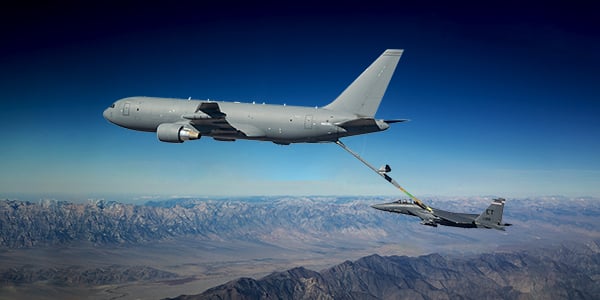Today, more KC-46A Pegasus tankers operate globally than any other aerial refueler except the KC-135. As more and more KC-46 multirole aircraft join the global fleet, the KC-46 continues to provide the U.S. and allied forces with clear advantages in global mobility. Here are six reasons why:
- The KC-46A has the ideal size and capability to get more booms in the air throughout the operational theater. The KC-46 delivers more fuel at all ranges and from shorter runways than the KC-135 aircraft it is replacing. The KC-46 also takes up less ramp space than competing commercial-derivative tankers, enabling mission reach at forward and austere airfields. All that adds up to more booms in the air where they are needed in the operational theater.
- The KC-46A has aerial refueling systems and capacity to support the full spectrum of missions. The KC-46 features boom and hose-and-drogue systems capable of refueling all U.S., allied and coalition military aircraft compatible with international aerial refueling procedures. These proven systems have already offloaded more than 60 million pounds of fuel to a variety of receivers — and the Pegasus features 212,000 pounds of fuel capacity to cover the full spectrum of offload missions. What’s more, the modernized fly-by-wire KC-46 boom offers a three-times-larger receiver envelope than the KC-135 aircraft it’s replacing.
- The KC-46A provides cargo, passenger and aeromedical evacuation rapid mobility. The KC-46 accommodates three times more cargo pallets, up to twice as many passengers and about 30% more aeromedical evacuation patients than the KC-135 aircraft it is replacing. With a large cargo door and cargo rollers, the Pegasus can be loaded or reconfigured between cargo, passenger or aeromedical evacuation modes in just two hours.
- The KC-46A is combat ready for survivability in contested environments. The KC-46 is built for survivability, with multiple layers of self-protection systems and combat-ready defensive countermeasures, including the Tactical Situational Awareness Suite; nuclear, chemical and biological hardening; flight deck armor; radio frequency threat detection; and infrared missile countermeasures.
- The KC-46A is purpose-built to be a tanker from Day 1, with in-line production efficiencies and life-cycle value benefits. By building the KC-46 in-line on the proven, successful 767 production line—as opposed to a post-production modification—the KC-46 incorporates combat-ready defensive features, lowers total lifecycle costs and can more easily integrate new capabilities and advanced technology.
- The KC-46A delivers data to the joint force, as well as fuel. Armed with data links and Advanced Battle Management System capability integrated in the KC-46’s flight-test-proven Wing Air Refueling Pods, the KC-46 connects multi-domain warfighters, providing tactical situational awareness and real-time information superiority.
The KC-46A is the only tanker that meets stringent U.S. civil and military aviation requirements. With more than 50 KC-46s in the fleet, and the Pegasus tanker now operationally approved for refueling nearly 70% of the receivers in the joint force, more and more capabilities are being proven out every day. Recent missions including Minimum Interval Take Off (MITO), Silver Paladin, and an austere dual defuel at Andersen Air Force Base’s Northwest Field in Guam have showcased the ever-increasing range of agile, combat-ready multi-mission capabilities that the KC-46 delivers.






















